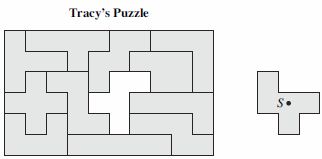General Information
Test Item Specifications
Students will identify the result of transformations on a two-dimensional figure.
Students will identify the transformations performed on a two-dimensional figure, given the original figure and the resulting figure after the transformation.
Students will determine the distance between two points located on the same vertical or horizontal line.
Students will determine the vertical and horizontal translations needed to get from one point to another on the coordinate plane.
Items may include dilations, translations, reflections, and rotations of two-dimensional figures.
Items that include translations will be limited to horizontal or vertical moves.
Items may include lines of reflection, which may or may not pass through the object being reflected.
Items may include centers of rotation, which may or may not be on the object being rotated.
Items may include clockwise and counterclockwise rotations, which are limited to Item Type Benchmark Clarifications Content Limits 45°, 90°, 180°, 270°, and 360°.
Items may present figures on coordinate grids, which may include all four quadrants.
Items may include the concepts of symmetry, congruency, or scale factors.
Items may include up to three transformations.
Items should be set in a real-world or mathematical context.
Graphics should be used in most of these items, as appropriate.
Sample Test Items (1)
| Test Item # | Question | Difficulty | Type |
| Sample Item 1 | Tracy is playing a puzzle game on the computer. She has placed all the pieces in the puzzle except for one, as shown below.
Tracy can complete the puzzle by performing two transformations on the remaining puzzle piece. Which two transformations should Tracy perform? |
N/A | MC: Multiple Choice |
Related Resources
Educational Software / Tool
| Name | Description |
| Transformations Using Technology | This virtual manipulative can be used to demonstrate and explore the effect of translation, rotation, and/or reflection on a variety of plane figures. A series of transformations can be explored to result in a specified final image. |
Lesson Plan
| Name | Description |
| Triangles on a Lattice | In this activity, students will use a 3x3 square lattice to study transformations of triangles whose vertices are part of the lattice. The tasks include determining whether two triangles are congruent, which transformations connect two congruent triangles, and the number of non-congruent triangles (with vertices on the lattice) that are possible. |
Virtual Manipulative
| Name | Description |
| Rotation of a Point | This virtual manipulative is an interactive visual presentation of the rotation of a point around the origin of the coordinate system. The original point can be dragged to different positions and the angle of rotation can be changed with a 90° increment. |
Student Resources
Educational Software / Tool
| Name | Description |
| Transformations Using Technology: | This virtual manipulative can be used to demonstrate and explore the effect of translation, rotation, and/or reflection on a variety of plane figures. A series of transformations can be explored to result in a specified final image. |
Virtual Manipulative
| Name | Description |
| Rotation of a Point: | This virtual manipulative is an interactive visual presentation of the rotation of a point around the origin of the coordinate system. The original point can be dragged to different positions and the angle of rotation can be changed with a 90° increment. |

